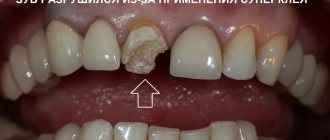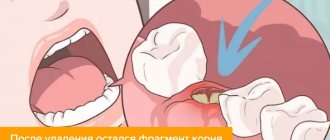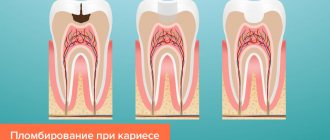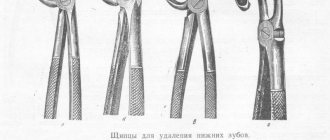When is a tooth root 100% subject to extraction?
Tooth root removal is performed if:
- the root is softened below the gum level,
- the root of the tooth is below the level of the surrounding bone tissue,
- the root of the tooth has cracks
:
- the root of the tooth is chipped
:
- the root of the tooth is severely damaged, for example as a result of canal treatment with resorcinol
:
- There are various inflammatory processes around the root and under the root of the tooth - cyst, cystogranuloma
:
- the root of the tooth is mobile,
- there is a deep dental pocket.
Methodology and recommendations in the postoperative period
With successful hemisection of the tooth root, the recovery period lasts no more than five days (in some situations, one day is quite enough). The only strict prohibition is not to eat for two hours after the operation.
The remaining recommendations are preventive in nature. In particular, to speed up the wound healing process, you should refrain from strenuous physical activity. Throughout the recovery period, the patient must regularly attend examinations with the attending physician.
How is tooth root removal done?
Are there any features or important points when removing a tooth root? Of course, any removal - be it tooth extraction, wisdom tooth removal, impacted tooth or tooth root should be carried out as atraumatically as possible, preserving the tissue structure
that surround a tooth or tooth root:
The goal of atraumatic root removal is to preserve bone
. Removal should be done painlessly.
The clinics of the German Implantology Center are supporters of atraumatic and painless removal. Our technologies have been proven over the years, and our patients feel very comfortable with them. It is no secret that many patients have fears about removal, and these fears sometimes postpone the surgical stage of treatment for a long time. In our clinics, we help patients overcome these fears. The patient may not be afraid of anything - both in the case of a single extraction and in case of multiple extractions of teeth
:
Disadvantages of piezosurgery for tooth extraction
1. The cost of atraumatic tooth extraction can be considered a disadvantage. It is slightly higher than with classical extraction. The cost is made up of professional training, training of a dental surgeon and the use of innovative, expensive equipment. In practice, the safety and reliability of the procedure compensate for the price component.
2. Limited prevalence of the technique. Not all clinics have the necessary equipment and staff training, especially clinics.
What is atraumatic tooth root removal?
What instruments does the surgeon use to achieve atraumaticity? For atraumatic removal, special instruments are used - thin, neat and elastic elevators that can minimally invasively penetrate and expand the periodontal tissue that connects the tooth root directly to the jaw. Using special instruments, the periodontal ligaments are cut so that the root can be removed as carefully as possible, in its “pure form.”
The vestibular plate that surrounds the bone is very thin. And we work with her carefully when removing teeth. It may also be necessary to saw the root of the tooth so that it can be removed in pieces. Sawing can be carried out with oscillating ultrasonic attachments - ultrasonic knives. Cutting the root of a tooth can be done quite effectively with a high-quality thin surgical dental bur, which has a certain length.
After cutting the root, the medial wall of the root is first removed, and then the vestibular wall of the root is removed. This allows for maximum preservation of surrounding tissue.
Then, after such removal, you can preserve the tooth socket or place an implant so that the bone is preserved as much as possible. Preservation of the tooth socket is carried out if there are no conditions for installing an implant at once, or if the patient undergoes delayed implantation.
If the roots of wisdom teeth are removed, the socket is not preserved; it is enough to remove them as atraumatically as possible. Let's talk about this in a little more detail.
Features of root removal of decayed wisdom teeth
Are there any difficulties when removing the roots of wisdom teeth? Removing the roots of wisdom teeth requires that the surgeon has sufficient experience. Often the roots of these third molars (wisdom teeth) are located close to the mandibular canal. Often the roots of molars are adjacent to the upper or lateral wall of the mandibular canal. The configuration of wisdom tooth roots is extremely diverse and sometimes extremely difficult to remove:
Therefore, when removing the roots of wisdom teeth, it is imperative that the patient undergo a CT scan. And the surgeon, as I said, needs to have some experience in surgical training in order to avoid the risks of removing the roots of such teeth and carry out the manipulation as efficiently as possible.
Like any root teeth, the roots of wisdom teeth are removed by cutting them along the roots. Wisdom teeth do not have problems because they are close to the angle of the lower jaw and there are strong cortical plates there. When I talked about thin vestibular walls, this comparison refers to the aesthetic zone of the smile, to the frontal group of teeth, including the premolars:
.
Types of deletion
To remove a tooth root, your dentist may use one of the following methods:
- tongs;
- using an elevator;
- using a drill.
Tooth root removal using forceps is most often used. For the upper roots, tools with straight ends are best, and for the lower roots, beak-shaped models are best. Bayonet pliers are universal and are suitable for all cases. If the tooth is single-rooted, then the rotation method, that is, rotation, is suitable for root removal. If a tooth has several roots, luxation is required.
If the roots are located far away, it may not be possible to remove them with forceps. Then various elevators are used, which operate on a principle similar to levers. The root is twisted out using this tool, and part of it appears on the surface. After this, it is already possible to remove it using forceps. Elevators come in corner and bayonet types. The former give good results on the roots of the lower teeth and their remains, while the latter are often used to remove “figure eights”.
If there are some peculiarities in the location of the roots or their strong “ingrowth” into the bone, the dentist will need a drill. The procedure can take quite a long time and requires high professionalism, however, like all types of medical care. Depending on the severity of the problem, removal surgery may be performed using one of the following methods:
- root hemisection—one of the roots of the tooth is removed;
- root extraction - it is completely removed.
What the patient needs to understand before root removal
You need to assess the health risks, you need to talk to the attending surgeon, find out about his experience. Quite often, tooth root removal is carried out, unfortunately, with the following negative consequences:
- gums are torn
- fractured bony vestibular plate
Sometimes when visiting such patients, you get the feeling that the tooth was not removed, but knocked out with something. There were cases when a patient’s extraction began in some clinic, and there, in the middle of the patient’s appointment, the doctor announced that he was unable to remove it, and the patients came to us in this form to remove the root of a tooth that was already in the extraction stage.
When removing the roots of wisdom teeth, you may face risks such as jaw fracture. One of the common risks of removing the roots of 3 molars is damage to the mandibular nerve
, leading to cuts and numbness in areas of the jaw. There is a risk of damaging the artery on the lingual side.
If, when a tooth is removed, a root or part of it is left behind, what should you do?
According to Russian treatment standards, the tooth root cannot be left during extraction. That is, if the patient was left with a root or part of it during removal, then this is considered a poorly performed surgical procedure.
In European countries there are doctors who agree that if there is no inflammation on the tooth and if the root part is not infected, and removal of the root leads to trauma, then only the cortical part of the root is removed, and the other part remains in the bone.
If the patient is left with a part of the root that is infected, then this is a problem. A cyst may develop and inflammation may develop. If the apical part was not infected, then everything heals and does not bring any trouble to the patient.
Tooth root without crown part
Can a tooth root without a crown cause inflammation in the gums or bone? Of course it can. There is a canal at the root of the tooth; if this canal is infected, then the problem will develop into a negative prognosis.
Inflammation, suppuration, periostitis, osteomyelitis - diseases can develop due to an infected tooth root. And the source of infection at the root must be removed; if it is impossible to remove the infection and preserve the root, then it must be removed.
Resection of the apex of the tooth root: price 2022
How much does resection of the apex of a tooth root cost? The price in economy class and mid-price clinics for 2022 will be from 4,500 to 10,000 rubles.
This difference in price will primarily depend on the position of the tooth - access to the roots of the front teeth is quite simple, and therefore the operation is carried out quite quickly. However, surgical access to the apices of the roots of the lateral teeth (especially 6-7 molars) is very difficult, so the operation requires much more time and effort from the doctor.
Important: the above cost already takes into account anesthesia, surgery, and repeated examinations. Whether medications for rapid bone restoration (“Kolapol” or “Kollapan”) are included in the price must be clarified in advance. Also, the above price does not take into account the cost of retrograde root canal filling, which is not always necessary.
Retrograde root canal filling during resection –
The very name of the technique “retrograde root canal filling” implies that after cutting off the apex of the tooth root with a drill, the upper part of the root canal will also be additionally sealed from the side of the cut off apex.
The essence of the technique (see video below) is that with the help of an ultrasonic nozzle, the upper part of the root canal is unsealed (2 mm deeper than the cut). After this, the unsealed part of the root canal is filled with a special material like “ProRoot” (ProRoot-MTA). This guarantees tight obturation of the root canal with the filling substance and will not allow infections to multiply in the root canal, which will cause re-formation of the cyst.
Retrograde filling is the gold standard when performing resection throughout the civilized world, because... almost completely eliminates the risk of re-formation of cysts. In Russia, it is rarely used due to the poor qualifications of most dental surgeons (some have not performed a single similar operation in their entire lives, and do not see the point in it), as well as due to the need to use expensive materials.
Retrograde filling: video
This method is especially necessary when resection is performed on teeth whose root canals were filled long ago, and the doctor decided that there is no need to additionally fill them before the operation. The latter sometimes happens when a tooth has an artificial crown, and retreatment of the tooth will lead to the need for re-prosthetics.
Is implantation possible after tooth root removal?
Yes, of course it is possible. And we at the clinics of the German Implantology Center widely use implantation after tooth root removal. Our conditions allow us to carry out implantation in such cases. And if we can achieve primary stability of the implant, then in 90% of cases
After removal, we immediately install the implant. We have rolled out the technology to perfection and gives excellent results.
Of course, with the exception of wisdom teeth, no implant is placed after their removal. But, by the way, wisdom teeth in this situation can be extremely useful, since they... can be transplanted to the place of the problem tooth being removed! Dental transplantation has been practiced in the clinics of the German Implantology Center since 2017, and our specialists have accumulated a wealth of clinical experience. Let's talk about this a little more.
Preparation
Formation of a complete clinical picture requires a comprehensive clinical examination. The list of diagnostic procedures prescribed to the patient includes not only a visual examination and oral questioning, but also radiography, orthopantomography, and intraoral imaging. A prerequisite for the preliminary stage is sanitation of the oral cavity, eliminating the possibility of infections getting into the surgical wound.
Upon completion of the sanitation, the selection of instruments used for the operation, antiseptic treatment, and removal of stone deposits from the surface of the operated tooth are carried out. Surgical intervention involves the use of local anesthesia, after which the root part begins to take effect.
An alternative to implantation is autotransplantation of wisdom teeth
Don't rush to remove your wisdom teeth. Firstly
, there must be clear indicators for their removal.
Secondly
, you don’t need to follow fashion, trends and delete eights just because “a girlfriend or friend deleted them and it’s cool.” There are a number of moments in life when wisdom teeth come to our aid.
It is not for nothing that nature has created a number of organs that duplicate each other in our body, for example, we have two lungs, two kidneys, which in case of problems with one lung/kidney come to our aid. Also with wisdom teeth: if a person (for some reason) has problems with the chewing group of teeth, for example, caries has destroyed the sixth or seventh tooth, then eights can come to the rescue. How so? After all, wisdom teeth are not involved in the chewing process. Yes, you are right here. But a wisdom tooth can serve as a donor, and it can be transplanted into place of a tooth with destroyed roots. Fantastic? No, advanced technologies in dentistry. This is called autotransplantation.
In the following video we show in detail the dental transplant surgery. The roots of two sixths of the patient's teeth had just been destroyed, and they were replaced by the patient's own wisdom teeth. And, by the way, this patient at the end of the video gives a detailed review after 1 year after the operation. Look, this is useful:
Get a consultation
We will answer all your questions before visiting the clinic!
+7
Online registration
Preparation of plasma membrane
The membrane is made in the morning or 4 hours after eating (water can be drunk, even necessary). The procedure takes about half an hour.
- In the treatment room, blood is taken from a vein in the patient's elbow.
- The biomaterial is placed in a specialized apparatus, where it is centrifuged to separate the plasma.
- In laboratory conditions, doctors obtain the necessary plasma and saturate it with anticoagulants.
The procedure is quite quick and painless. To minimize risks, you should carefully approach the search for a good clinic and an experienced doctor. Implantmaster employs highly qualified specialists who regularly improve their skills and knowledge.
Removal using a piezo scalpel with a periotome
At the Implantmaster clinic, all surgical interventions are performed using anesthesia. Our specialists perform atraumatic removal of any teeth using ultrasound.
The dentist-surgeon, first of all, uses a periotome to separate the adjacent gum from the tooth on all sides. To preserve the bone septum between the roots, the doctor separates the roots from each other. An innovative piezo scalpel - the VarioSurg LED ultrasonic surgical system - separates the roots from the coronal part and their subsequent segmentation. Removal is as safe and painless as possible. Even the most difficult operations are carried out without further complications.
Application of blood plasma membrane
The use of platelet membranes containing cell growth factors accelerates tissue regeneration and healing. During surgery, the membrane covers the defect, implanted bone material or artificial root. Sometimes a fibrin clot is combined with the patient's bone material and introduced into the defect area. Afterwards, suture material is applied. If the membrane was installed to prevent inflammation, then sutures are not applied. It is not advisable to rinse your mouth during the first 3 days.
The introduction of a platelet membrane naturally activates cellular growth factors of the jaw bone and periodontal tissues, increasing the rate of recovery. Regeneration and acceptance of implants or bone material by the body is much faster, and the likelihood of inflammation is significantly minimized.
Blood plasma membranes have a positive effect on:
- increase in the rate of cellular growth factor in the bone after implantation;
- absence of allergies that could occur when interacting with foreign materials;
- accelerated gum recovery after implantation or plastic surgery;
- prevention of inflammation around the implant;
- reduction of swelling and pain after surgical procedures;
- optimal tightening of the socket after tooth extraction;
- minimizing inflammation during gingival curettage and cleaning periodontal pockets.










